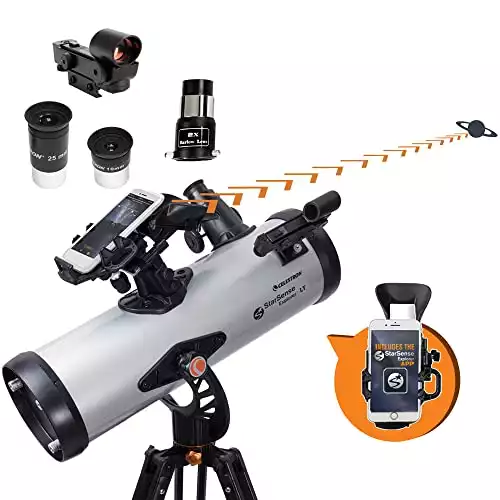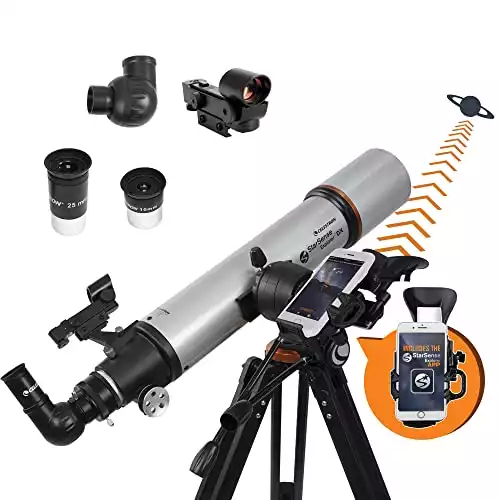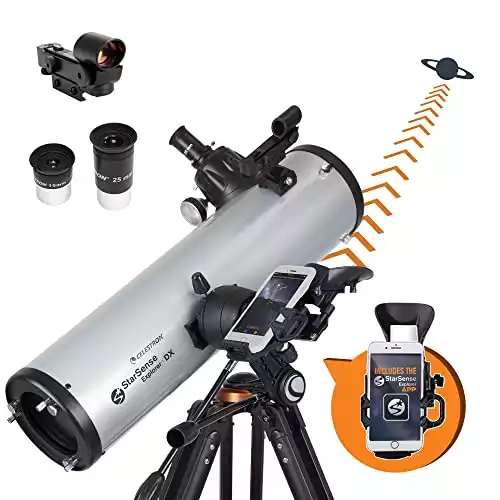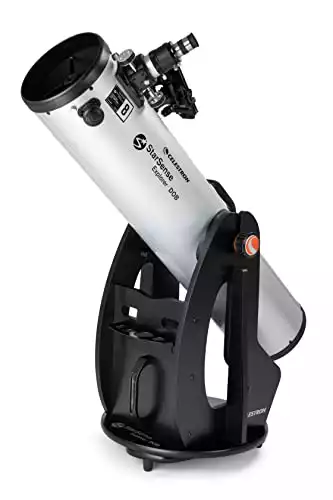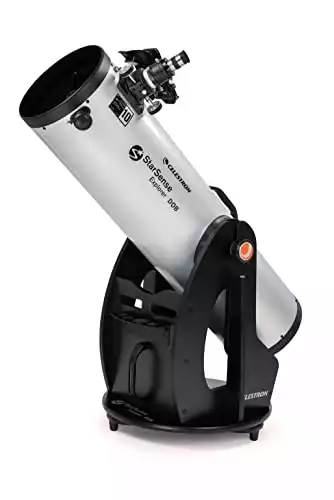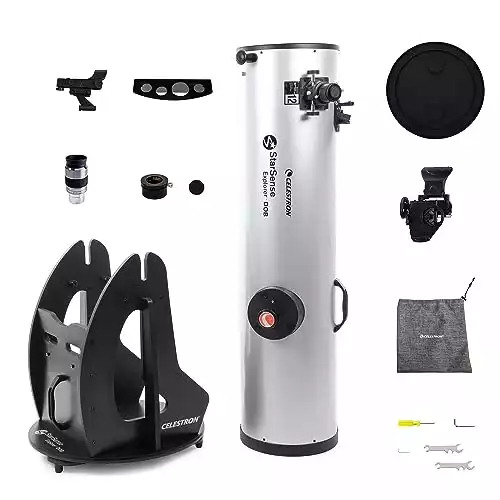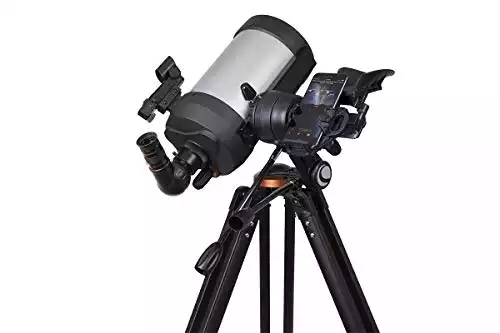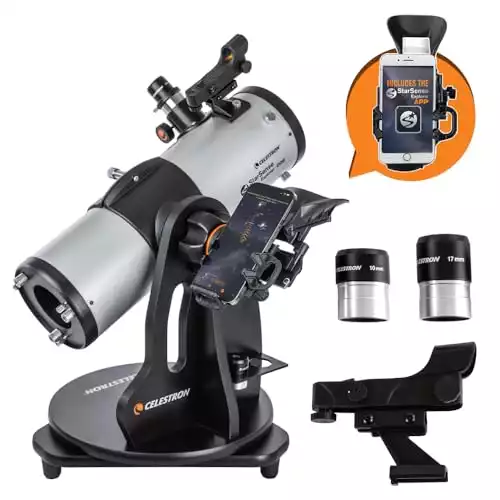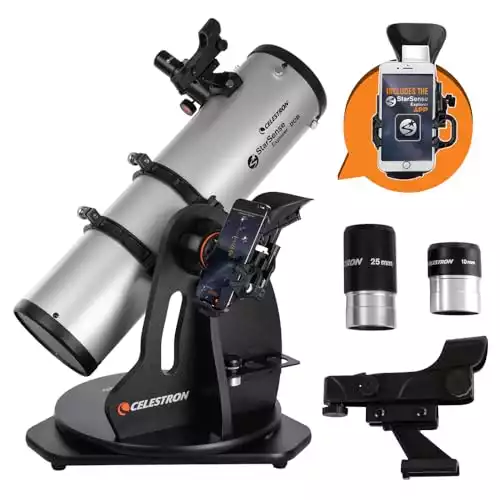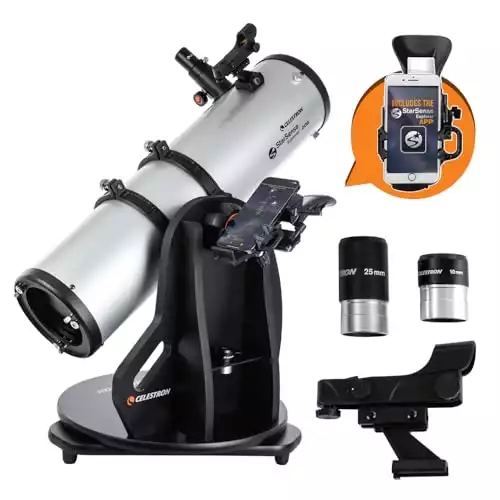Celestron StarSense Explorer telescopes use your smartphone to help you easily find objects in the night sky.
But with 11 different models, which is the best StarSense Explorer telescope for you?
We provide here an overview of the differences between each model so that you can understand the pros and cons of each.
Overall, our top picks for different buyers are:
- Best Value: Celestron Starsense Explorer DX 130AZ – Great performance at a mid-range price
- Budget Pick: Celestron StarSense Explorer LT 114AZ – One of the cheapest but still boasting good specs
- Most Powerful: Celestron StarSense Explorer 12″ Dobsonian – Huge power but also huge in size!
StarSense Explorer Comparison Table
- Refractor
- 80mm (3-inch) aperture
- 900mm focal length
- 9.2lbs weight
- Newtonian Reflector
- 114mm (4.5-inch) aperture
- 1000mm focal length
- 10.4lbs weight
- Refractor
- 102mm (4-inch) aperture
- 600mm focal length
- 14.2lbs weight
- Newtonian Reflector
- 130mm (5-inch) aperture
- 650mm focal length
- 18lbs weight
- Dobsonian Reflector
- 203mm (8-inch) aperture
- 1200mm focal length
- 43.4lbs weight
- Dobsonian Reflector
- 254mm (10-inch) aperture
- 1200mm focal length
- 54.8lbs weight
- Dobsonian Reflector
- 305mm (12-inch) aperture
- 1500mm focal length
- 83lbs weight
- Schmidt-Cassegrain
- 125mm (5-inch) aperture
- 1250mm focal length
- 14.2lbs weight
- Tabletop Dobsonian
- 114mm (4.5-inch) aperture
- 450mm focal length
- 12.6lbs weight
- Tabletop Dobsonian
- 130mm (5.1-inch) aperture
- 650mm focal length
- 19.2lbs weight
- Tabletop Dobsonian
- 114mm (5.9-inch) aperture
- 750mm focal length
- 25lbs weight
LT / DX / AZ – What Do The Differences Mean?
It can be pretty hard to decipher what all the names and acronyms mean, so we have put together this summary:
- LT = Refers to how the smartphone is attached. LT models have the phone sit on top of the telescope tube
- DX = Also refers to how the smartphone is attached. DX models have the phone sit off the side of the mount (Note, LT vs DX makes very little difference to you)
- The number = This refers to the aperture of the telescope, which is the best indicator of its power and the quality of the views it will provide. The higher this is the better, but also more expensive. Confusingly, sometimes this is in millimeters (80/114/150 etc) and sometimes in inches (5/8/12 etc).
- AZ = Refers to those that come with an alt-azimuth mount upon the tripod. This is the component with which you control where the telescope points and looks.
- Dobsonian = A telescope type where a reflector telescope sits a upon a base on the floor. These tend to be physically very large but provide good value for money in terms of price to aperture.
- Tabletop Dobsonian = A telescope type where a reflector telescope sits a upon a base that is designed to be used upon a raised surface like a table. These can be more convenient for home use.
StarSense Explorer Technology
All of these 11 telescopes feature the StarSense Explorer technology that provides a great halfway point between computerized (GOTO) telescopes and manual ones (see FAQs below if you want more information on GOTO telescopes).
What these StarSense Explorer telescopes do is attach your smartphone then, using the app, scan the night sky above you, tell you what you can see on that particular night, and then guide you to it.
See in this screenshot here from the app:
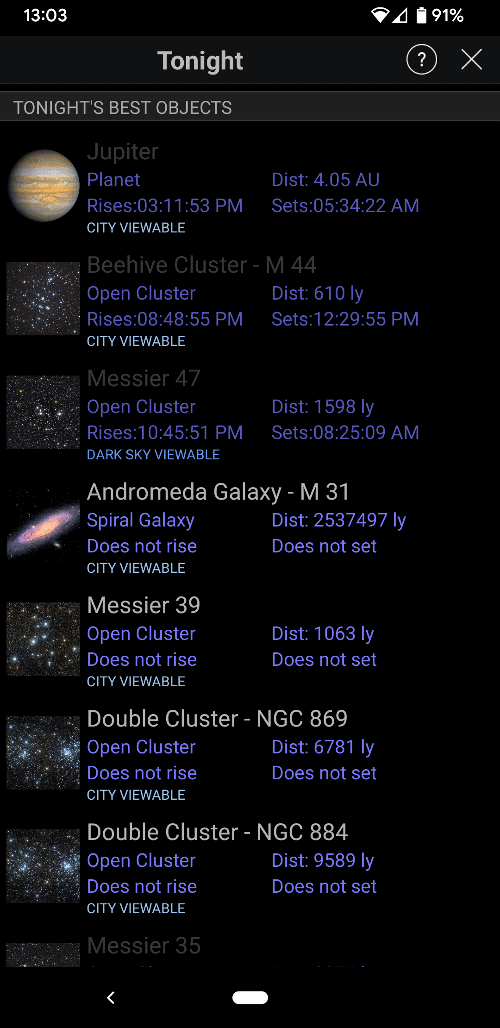
For example, if Saturn or the Andromeda galaxy are above you that night, you can select them on the app and then follow the arrows on the app to point the telescope at them.
This is the app guiding me to view Andromeda:
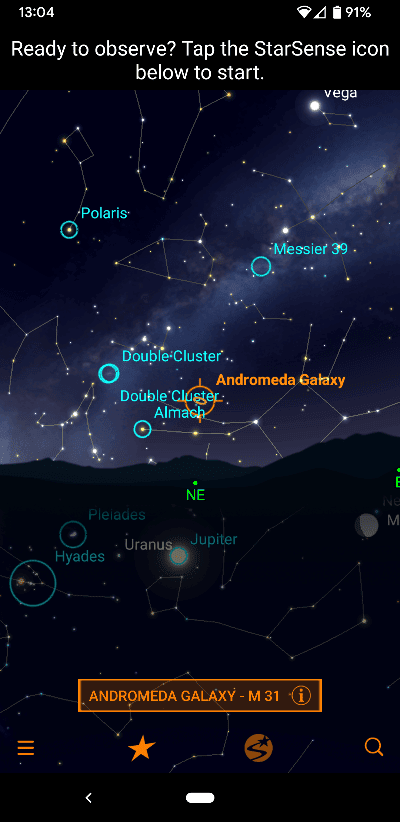
Here is a quick video that shows how this works:
This is a great, innovative feature that takes advantage of the smartphone that you probably already own, and gives you something simpler and cheaper than a fully computerized telescope.
There are a few differences between each of the models, so let’s look at each of them in turn to help decide what’s right for you.
Celestron StarSense Explorer LT 80AZ
Starting with the Celestron StarSense Explorer LT 80AZ. You can take a number of its key characteristics from its name:
- Celestron = Manufacturer
- StarSense Explorer = the telescope range, as specified above
- LT = refers to how the smartphone is attached. The LT models like this simply have the phone sit on top of the telescope tube. The DX models have the phone sit off the side of the mount. This makes very little difference.
- 80 = the 80mm aperture of the telescope. This is the key measurement of its power and the views it can deliver. The higher this is, the better.
- AZ = refers to the alt-azimuth mount that comes with it. This is the component on top of the tripod with which you control where the telescope points and looks. Alt-Az mounts are best for astronomy and the simplest to use.
Not in the name, but worthy of note, is that it is a refractor telescope (as opposed to a reflector). This refers to the telescope’s build and shape.
Generally, refractors are less bulky and easier to operate. However, reflectors tend to give you more aperture (power) for the same price, with the downside being the bigger size and more cumbersome operation.
This model and the 102 AZ are refractors. The 114AZ and 130AZ are reflectors (as well as the two dobsonians).
Overall, this is the most entry-level of the telescopes in this range.
It is the most portable (being the lightest) and is generally the cheapest. These reasons may make it the best option for kids. However, it has the lowest aperture, which will limit your viewing capacity.
It’s a great budget option, but if you have the space and intend to use it mostly at home then the 114AZ will give you more power for a similar price. If you prefer a smaller refractor, then the 102AZ below could work but will almost certainly cost more.
Pros
- The lightest, most portable, and easiest to operate in the range
- Generally the cheapest (although check prices)
Cons
- The 80mm/3-inch aperture is the smallest of the range and will limit the brightness and clarity with which you can view night sky objects.
Key specifications
- Type: Refractor
- Aperture: 80 mm (3.25-inch)
- Focal Length: 900 mm (35-inch)
- Focal Ratio: F/11.3
- Weight: 9.2 lb (4.2 kg)
- Accessories: Two eyepieces (10 mm and 25 mm), 2x Barlow lens, smartphone dock, erect image diagonal, red dot finderscope, tripod.
Smartphone App-Enabled Telescope
- Let your iPhone or Android phone take you on a guided tour of the night sky.
- The app tells you what’s in the sky based on your exact time & location. Follow the on-screen arrows to your desired target. When the bullseye turns green, it’s ready to view in the telescope’s eyepiece.
- View planets, brighter nebulae, galaxies, and more.
- Too bulky for easy travel
Celestron StarSense Explorer DX 102AZ

In order of aperture, the Celestron Starsense Explorer DX 102AZ is the second most powerful in the range.
As noted above, the 102 in the name refers to the telescope’s aperture of 102mm (4-inch). This is the best measurement of a telescope’s capacity to provide good views.
It shares many of the characteristics of the other refractor in the range above in that it is smaller, lighter, and less cumbersome to operate, but it is more powerful with the larger aperture and you will be able to see more through it.
In addition, the faster focal ratio of F/6.5 will also make it better at taking astrophotography images.
Overall, this is a great option if you prefer a smaller and less cumbersome refractor telescope, but want something more powerful than the 80mm option above. The downside is that it is generally more expensive.
Pros
- Most powerful refractor in the range
- Improved focal ratio for better photography
- Smallest telescope tube
- Less cumbersome than the larger models below
Cons
- Less power (aperture) than the two reflector options below
- Generally the most expensive
Key specifications
- Type: Refractor
- Aperture: 102 mm (4-inch)
- Focal Length: 660 mm (26-inch)
- Focal Ratio: F/6.5
- Weight: 14.2 lb (6.4 kg)
- Included accessories: Two eyepieces (10 mm and 25 mm), smartphone dock, erect image diagonal, red dot finderscope, tripod.
102mm Refractor Smartphone App-Enabled Telescope
- 102mm Refractor. 14lbs weight.
- StarSense Explorer app automatically generates a list of objects currently visible, including planets, nebulae, galaxies, star clusters and double stars.
- Manual altazimuth mount makes it easy to follow the on-screen arrows to your desired target. When the bullseye turns green, it’s ready to view in the telescope’s eyepiece.
Celestron StarSense Explorer LT 114AZ
The Celestron StarSense Explorer LT 114AZ is different from the models above in that it is a reflector telescope.
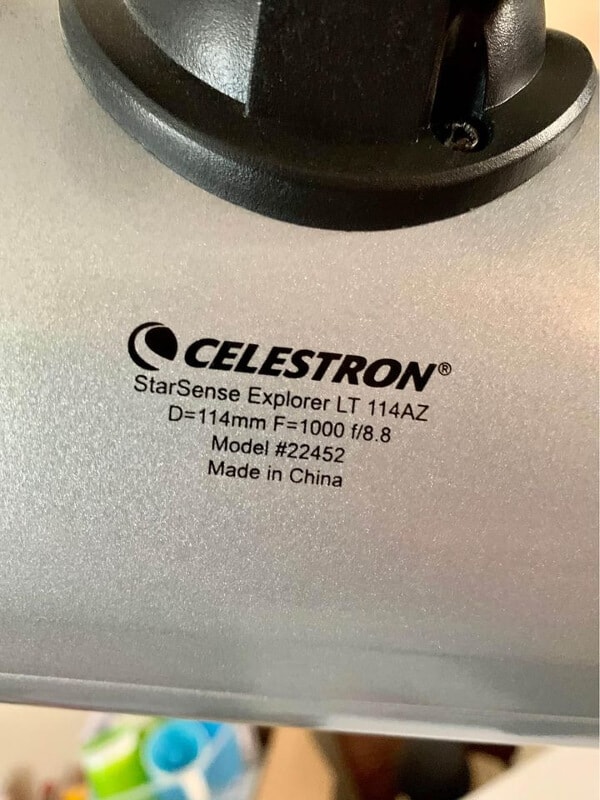
This means that it is larger and heavier. Also, you look into an eyepiece on the side, rather than at the bottom. Often this makes for more comfortable viewing with less stooping.
It has an aperture of 114 mm (4.5 inches). This is more powerful than the models above and will provide better views.
Pros
- More aperture and better views with 4.5 inch aperture
- One of the cheaper options alongside the 80AZ model
Cons
- Larger, heavier, more cumbersome, and less portable than the refractors above
Key specifications
- Type: Reflector
- Aperture: 114 mm (4.5-inch)
- Focal Length: 1000 mm (39-inch)
- Focal Ratio: F/8.8
- Weight: 10.4 lb (4.7 kg)
- Included accessories: Two eyepieces (10 mm and 25 mm), smartphone dock, erect image diagonal, red dot finderscope, tripod.
114mm Newtonian Reflector Smartphone App-Enabled Telescope
- 114mm (4.5”) Newtonian reflector with highly reflective coatings. 10.4 lbs weight.
- StarSense Explorer app automatically generates a list of objects currently visible, including planets, nebulae, galaxies, star clusters and double stars.
- Manual altazimuth mount makes it easy to follow the on-screen arrows to your desired target. When the bullseye turns green, it’s ready to view in the telescope’s eyepiece.
Celestron StarSense Explorer DX 130AZ
The Celestron Starsense Explorer DX 130AZ model is bigger in terms of both physical bulk and aperture.
The 130 mm (5-inch) aperture is fairly large and will enable great views of planets and deep-sky objects when the night sky conditions are right.
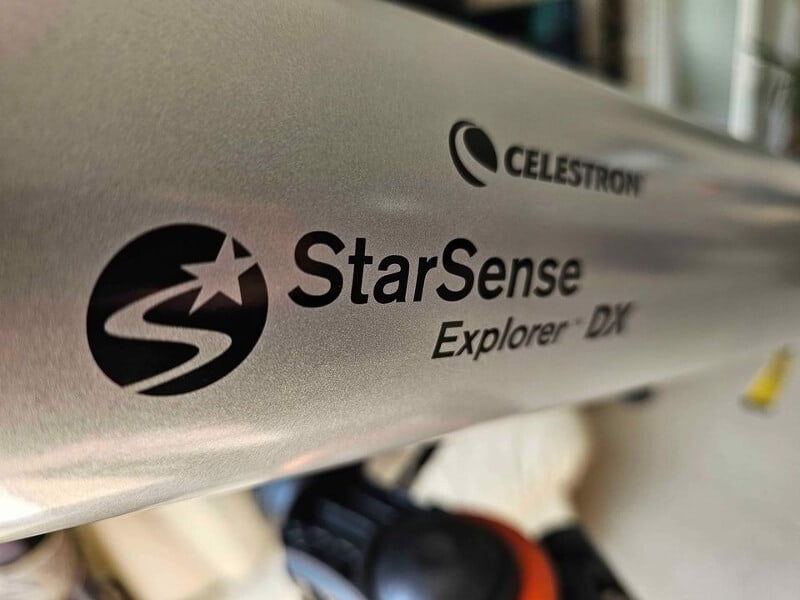
Pros
- Large aperture for the best views of objects in the night sky
Cons
- Larger, heavier, more cumbersome, and less portable than the other models
- The most expensive (alongside the 102AZ)
Key specifications
- Type: Reflector
- Aperture: 130 mm (5-inch)
- Focal Length: 650 mm (25-inch)
- Focal Ratio: F/5
- Weight: 18 lb (8.2 kg)
- Included accessories: Two eyepieces (10 mm and 25 mm), smartphone dock, red dot finderscope, tripod.
130mm Newtonian Reflector Smartphone App-Enabled Telescope
- Smartphone-interactive telescope that automatically generates a list of objects currently visible above you on any night, including planets, nebulae, galaxies, star clusters and double stars.
- Follow the on-screen arrows to your desired target. When the bullseye turns green, it’s ready to view in the telescope’s eyepiece.
- Great for beginners and families
Celestron Starsense Explorer 8″ Dobsonian
There are three Dobsonians in the range – this Starsense Explorer 8-inch Dobsonian, and the 10-inch and 12-inch versions covered below.
In short, this is a brilliant telescope for viewing the night sky. The 8-inch aperture is huge and will provide few limitations to what you can see.
The downside to large dobsonians like this is the size – they are heavy and large. In fact, they are as big as a fairly small person, so this isn’t an option if you have limited space or want something portable.
Watch this video from Celestron for a quick overview of these two models and also to give you a good perspective of the size of them standing next to a grown man:
Pros
- Large aperture for great viewing
Cons
- Heavy and large. You need to consider where you will use it and store it.
- Not portable. You won’t be taking this on trips.
Key specifications
- Type: Dobsonian Reflector
- Aperture: 203 mm (8-inch)
- Focal Length: 1200 mm (47-inch)
- Focal Ratio: F/5.9
- Weight: 43.4 lbs (19.7 kg)
- Included accessories: 25 mm eyepiece, smartphone dock, red dot finderscope, base.
8-inch Dobsonian Smartphone App-Enabled Telescope
- Large 8-inch aperture parabolic primary mirror and high-reflectivity XLT optical coatings give you the power to view all the best celestial objects.
- StarSense Explorer app automatically generates a list of objects currently visible, including planets, nebulae, galaxies, star clusters and double stars.
- Manual altazimuth mount makes it easy to follow the on-screen arrows to your desired target.
- Big and heavy
Celestron Starsense Explorer 10″ Dobsonian
Boasting a whopping 10-inch aperture, the Celestron Starsense Explorer 10″ Dobsonian is a beast of a telescope.
It has all the same pros and cons as the 8-inch model above, except that they are even more extreme – even higher power and viewing capacity, but also even heavier and bigger.
Overall, this is a brilliant option if you want near-perfect viewing of planets and galaxies and have the space to use it.
Pros
- Very large aperture for great viewing.
Cons
- Even heavier and larger. You need to consider where you will use and store it.
- Not portable. You won’t be taking this on trips.
Key specifications
- Type: Dobsonian Reflector
- Aperture: 254 mm (10-inch)
- Focal Length: 1200 mm (47-inch)
- Focal Ratio: F/4.7
- Weight: 54.8 lb (24.9 kg) (fully assembled)
- Included accessories: 25 mm eyepiece, smartphone dock, red dot finderscope, base.
10-Dobsonian Smartphone App-Enabled Telescope
- Perfect for beginners - attach your smartphone and let it guide you
- Huge 10-inch aperture for great views
- Great budget option in terms of price-to-aperture
Celestron Starsense Explorer 12″ Dobsonian
Smartphone app-Enabled Dobsonian Telescope
- Huge 12-inch aperture
- Easy to use and great for beginners
- No GOTO means no cables or power source needed
- Great price-to-aperture value
- Bulky and heavy
- Not great for astrophotography
Celestron Starsense Explorer DX 5
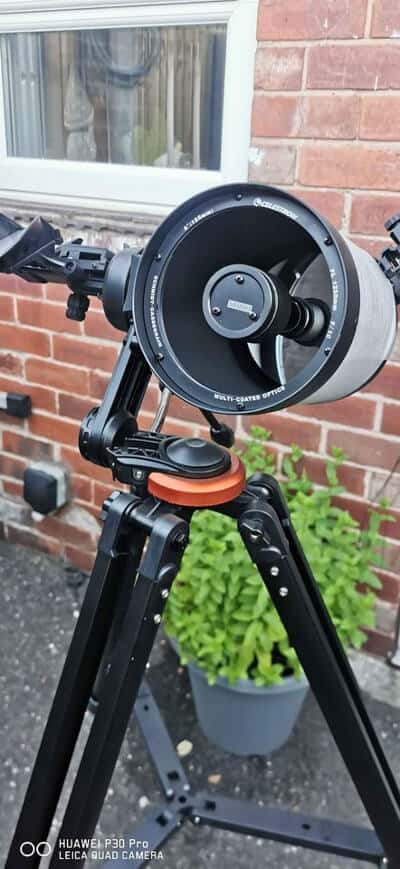
This DX5 is Celestron’s classic 5-inch Schmidt-Cassegrain (SCT) telescope tube with a hand-operable mount and the Starsense Explorer functionality that allows you to connect your smartphone and allow it to guide you, like the models above.
The advantage with these models is that the Schmidt-Cassegrain design allows high aperture in a much more compact body.
Therefore these models will suit those where space is at a premium at home and would prefer something smaller, easier to store, and more portable.
This is a great option if you want high power in a compact package and have the budget to pay a little more for this.
Pros
- Good 5-inch aperture
- Trusted Celestron Schmidt-Cassegrain design
- Small and compact for the power it provides
Cons
- More expensive than other models like the Dobsonians that provide a better price-to-aperture ratio, but are also significantly larger
Key specifications
- Type: Schmidt-Cassegrain
- Aperture: 125 mm (5-inch)
- Focal Length: 1250 mm (49-inch)
- Focal Ratio: F/10
- Weight: 14.2 lb (6.4 kg) (fully assembled)
- Included accessories: 3 eyepieces, red dot finder, tripod
5-inch Schmidt-Cassegrain Smartphone-App Enabled Telescope
- 125mm (5-inch) Schmidt-Cassegrain Telescope. 28lbs weight.
- StarSense Explorer app automatically generates a list of objects currently visible, including planets, nebulae, galaxies, star clusters and double stars.
- Manual altazimuth mount makes it easy to follow the on-screen arrows to your desired target. When the bullseye turns green, it’s ready to view in the telescope’s eyepiece.
Celeston StarSense Explorer 114/130/150 Tabletop Dobsonian
There are three in this tabletop dobsonian range with the difference being the aperture – 114mm, 130mm, or 150mm.
The higher the better for this in terms of views, but also the more expensive.
These are actually the same reflector telescopes (OTAs) that you get with the LT 114AZ and DX 130AZ, just on a tabletop base, rather than a tripod.
The viewing capacity will be the same, so it is up to you to decide what suits you best:
- A tabletop design is good for families to sit around a garden table and use and is easier to setup
- A tripod-mounted telescope can work better where there is no tabletop surface and can be taken out more easily to use in fields or on trips
Check prices here:
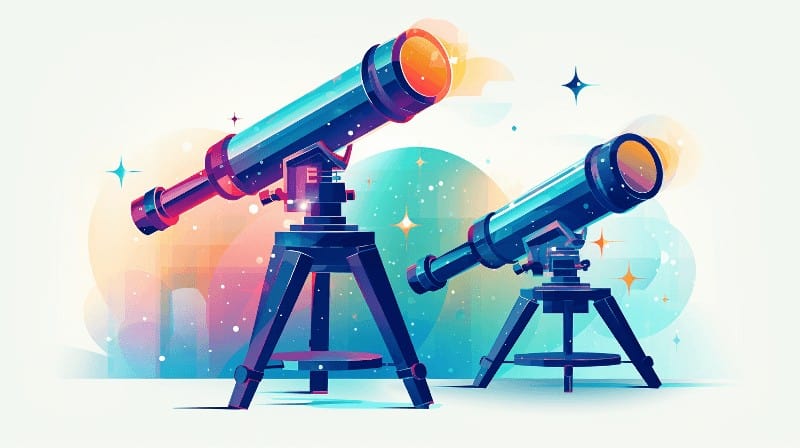
Celestron StarSense Explorer FAQs
Are the Celestron StarSense Explorer good telescopes?
Yes, the Celestron StarSense Explorer telescopes are good. There are six different models to suit different budgets and priorities.
Celestron is one of the most reliable telescope manufacturers in the world.
What can you see with Celestron StarSense Explorer?
What you can see will improve according to the size of the aperture. The 80 mm model is the smallest with the weakest viewing capacity, and the 254 mm model is the largest with the best.
With all models, if the conditions are right you should be able to view the planets of the solar system and deep-sky objects like other galaxies. These views will be much brighter and clearer with the larger aperture models.
Which Celestron StarSense telescope is best?
If you disregard factors like size and portability, then the Celestron Starsense Explorer 12″ Dobsonian is the best as it has the highest aperture and will provide the best views.
Can you take pictures with the Celestron StarSense?
Yes, you can take astrophotography pictures with the Celestron StarSense Explorer telescopes using a smartphone adapter like this basic one or this premium one.
There is an issue though in that if you are using your smartphone attached to the telescope to use the StarSense technology then you won’t be able to attach it to the eyepiece to take a photo at the same time.
You’d have to either detach the phone and try not to move the telescope or use two separate phones.
Celestron StarSense Explorer vs Celestron AstroMaster Telescopes: How do they compare?
Some of the Celestron Astromaster telescopes use similar OTAs (telescope tubes) and similar AZ mounts.
They are completely manual though and do not have the StarSense technology and smartphone interactivity (although you may be able to replicate this with other adapters and apps.
Celestron StarSense Explorer vs Celestron NexStar Telescopes: How do they compare?
The Celestron NexStar telescope range are all full computerized compound / catadioptric telescopes.
This means they have the advantages of GOTO technology and are smaller telescopes in terms of physical size. They are generally more expensive though.
See our overview of all the different Celestron NexStar models.
Are Celestron StarSense Explorer telescopes computerized / GOTO?
Celestron StarSense Explorer telescopes are manual, not computerized, but their design gives you many of the advantages of this technology. For information:
- Computerized/GOTO telescopes feature a mount that operates where the telescope points and can find astronomical objects for you to look at automatically (usually operated by a hand controller). These are really good, but can be expensive and require a power source.
- Manual telescopes have a mount that you operate by hand and you usually have to locate things in the sky by looking for them with your eyes. These are cheaper, but make it much harder to find things, especially if you not an experienced astronomer.
The StarSense technology on these telescopes enables you to use your smartphone to give you much of what you’d get from a GOTO telescope. They won’t find things automatically for you, but they will search for what you can see and guide you to look at whatever planet or object you want to look at.
The other advantage is that no power source is needed.
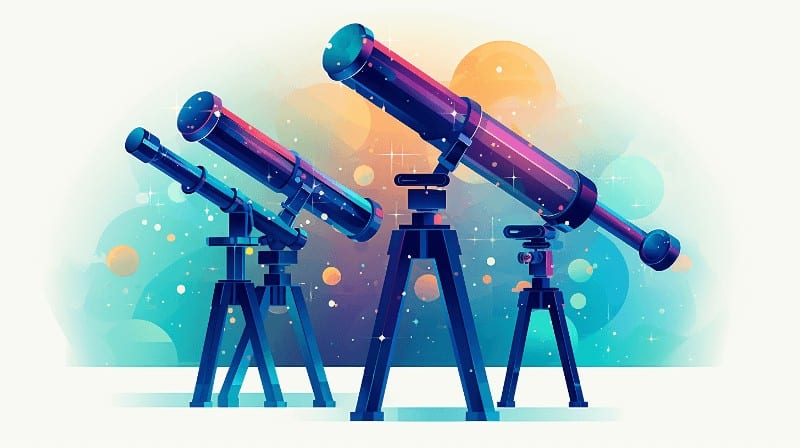
Conclusion: Which Celestron StarSense Explorer is best for you?
Overall, in terms of which one is right for you, there are two key things to consider- price and size.
Choosing the right model for your circumstances will hopefully help you get the most use out of these great telescopes.
Please let us know if you have any questions by leaving a comment below.
Other sources of information:



